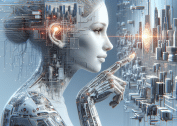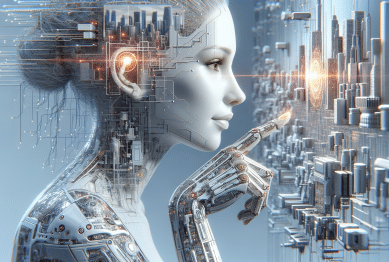Artificial intelligence is shaping lives in more ways than many realize, from health apps to smart assistants. This guide explores how AI weaves into everyday routines, discusses evolving tech trends, and shares insight about what’s driving the next wave of intelligent systems.
The Everyday Presence of Artificial Intelligence
AI technology often goes unnoticed as it integrates quietly into the digital ecosystem of daily routines. From unlocking a phone with a face scan to asking a smart speaker about the weather, these artificial intelligence systems are constantly at work. The seamlessness of these experiences highlights how natural language processing and machine learning personalize digital interfaces, making them feel intuitive. Imagine getting directions from a navigation app that learns preferences over time or receiving curated playlists from a streaming service powered by algorithms analyzing listening habits. These subtle elements illustrate AI’s relentless progress and its focus on enhancing comfort and efficiency.
While AI serves countless practical purposes, it also fuels growth in predictive analytics across multiple industries. For instance, healthcare providers apply predictive analytics to anticipate patient needs, sometimes even flagging potential health issues before symptoms arise. Financial institutions use similar technology to alert users about suspicious transactions or to recommend spending habits, further entwining artificial intelligence with decision-making processes. The ripple effect extends to online retail, where AI-driven recommendation systems suggest products based on browsing behaviors. This intersection of data analysis, automation, and personal touch amplifies convenience but also raises questions about data privacy and transparency.
The adoption of artificial intelligence has a transformative impact on user expectations. Many now expect digital services to anticipate their needs or adapt to their behaviors. This shift signals the dawn of a new relationship between humans and technology, where the line between interaction and automation is blurred. While efficiency is a clear advantage, ongoing discussions focus on establishing trust, responsible design, and equitable access as AI’s presence grows stronger in society https://www.nap.edu/read/24661/chapter/1.
Smart Homes and Privacy Considerations
Smart home technology is rapidly becoming standard in modern living spaces, offering automation for lights, thermostats, and even household appliances. Sensors embedded in these devices use artificial intelligence to learn daily habits and provide tailored comfort—adjusting temperature when someone enters a room or turning off appliances automatically. These conveniences are powered by machine learning algorithms continuously analyzing input data to improve over time. With their connected nature, smart home devices bring flexibility and ease, especially as voice assistants seamlessly coordinate various tasks.
While the convenience of AI-enabled homes attracts many, privacy remains a primary concern. These devices collect and store significant volumes of information, from voice recordings to motion patterns and energy usage. The aggregation of personal data is necessary for systems to learn preferences accurately, but it also raises questions about data ownership, third-party access, and the security of information stored in the cloud. Consumers are increasingly scrutinizing what happens behind the scenes, driving demand for better transparency and robust data protection strategies from technology providers.
Addressing privacy in smart homes requires ongoing dialogue between users, manufacturers, and policymakers. New standards are emerging to ensure users can control their data—deciding whether to delete records or limit device access. Initiatives such as privacy dashboards, enhanced encryption, and regular updates aim to balance technological advancement and personal rights. The evolution of AI in the home thus becomes not only a story of innovation but also one of responsible stewardship https://www.nist.gov/privacy-framework.
Healthcare Innovation Through Artificial Intelligence
Modern healthcare has been profoundly transformed by the adoption of artificial intelligence. Diagnostic imaging tools, for instance, now utilize deep learning algorithms to detect abnormalities that could have previously gone unnoticed. AI-driven clinical decision support systems help providers identify risk factors and recommend evidence-based interventions. From radiology to personalized treatment suggestions, these innovations improve the accuracy and efficiency of healthcare delivery, giving providers a crucial edge in patient care.
AI-powered chatbots and virtual assistants have taken patient interaction to a new level. These systems answer health queries, triage symptoms, and even provide reminders for medication adherence. By extending the reach of professional advice and support, artificial intelligence addresses resource constraints while fostering continuous engagement. In remote areas, AI solutions have even helped bridge gaps where healthcare professionals are scarce, offering tailored care recommendations or facilitating telemedicine appointments.
Yet, the integration of AI in healthcare introduces unique challenges as well. Ethical considerations around algorithmic bias, patient data security, and informed consent require continual attention. Collaborative efforts are underway between medical experts, computer scientists, and regulatory bodies to set guidelines that maximize benefits while mitigating risks. Ongoing research focuses on transparency and fairness in algorithmic decision-making to enhance public trust in AI-driven healthcare solutions https://www.nih.gov/news-events/nih-research-matters/artificial-intelligence-health-care.
AI Behind the Wheel: Transforming Transportation
Artificial intelligence is playing a pivotal role in revolutionizing the world of transportation. Autonomous vehicles rely on advanced machine learning models to perceive surroundings, interpret traffic signals, avoid obstacles, and make split-second decisions. These vehicles employ sensors and real-time data analytics to adapt to changing conditions, promising safer and more efficient journeys. While the concept of self-driving cars may seem futuristic, AI-powered features like adaptive cruise control and collision warnings are already standard in many modern vehicles.
Public transit systems are also benefitting from artificial intelligence. Predictive algorithms optimize bus and train schedules, factoring in realtime traffic and passenger demand. Ticketing systems harness AI to manage crowd flow and enhance travel experiences. Even logistics and delivery networks rely on automated dispatching, route optimization, and shipment tracking, allowing businesses to minimize delays and improve resource allocation. All these elements contribute to smarter mobility solutions and a robust digital infrastructure.
Despite the promise of AI in transportation, regulatory hurdles and ethical dilemmas remain. Ensuring road safety, managing liability, and developing trustworthy human-machine interfaces are active areas of research. There are also broader implications for employment within driving and logistics sectors. Policymakers, industry leaders, and academic institutions continually assess how to responsibly advance AI-driven mobility while prioritizing public safety and social well-being https://www.transportation.gov/research-technology/artificial-intelligence.
Job Market Changes and Future Skills in the Age of AI
The proliferation of AI across industries is reshaping the job market and the nature of work itself. While automation can displace repetitive tasks, AI also creates the need for new skill sets—particularly in areas such as data science, programming, and algorithm design. Roles focused on managing, interpreting, and maintaining intelligent systems are rapidly emerging, requiring continuous learning and upskilling for those active in the workforce. Educational institutions and employers are responding by developing tailored training programs and promoting digital literacy initiatives.
Beyond technical abilities, sectors value skills that complement machine intelligence, such as problem solving, critical thinking, and emotional intelligence. As AI tools take over routine workflows, humans become essential in strategic planning, ethical oversight, and creative collaboration. Efforts to promote inclusivity ensure that opportunities arising from AI advancements are accessible to a broad demographic, mitigating disparities and supporting an adaptable workforce. Partnerships between academia, government, and private industry serve as the backbone for these initiatives.
The transformation of the job landscape requires thoughtful policy and support for workers navigating this digital era. Governments are considering reskilling programs and safety nets for displaced employees, particularly in sectors most affected by automation. Empowering individuals to engage with artificial intelligence as collaborators—rather than competitors—reinforces the role of human ingenuity in the future economy. Staying informed about these trends helps shape a proactive approach to career development https://www.brookings.edu/research/ai-and-the-future-of-work/.
AI in Education: Learning and Adaptive Technologies
Artificial intelligence is changing how information is shared and absorbed in educational settings. Personalized learning platforms use data analytics to adapt materials to a student’s strengths, weaknesses, and learning pace. This individualization ensures more effective outcomes and supports learners of all levels, from early education through lifelong professional training. Platforms powered by AI provide educators with insights to identify students who might need additional intervention or alternative instructional methods.
Virtual tutors and interactive educational applications powered by AI are increasingly common in classrooms and remote learning environments. These tools complement traditional teaching methods by providing instant feedback and fostering self-directed learning. AI-driven assessments can grade assignments quickly and accurately, freeing teachers to concentrate on mentoring and creative lesson planning. By facilitating collaboration and knowledge sharing, these technologies encourage a more dynamic learning experience for students.
The integration of AI into education does, however, require careful oversight to ensure fairness and system reliability. Concerns around algorithmic bias and equitable access to technology remain key topics of discussion. Ongoing research addresses strategies to foster diversity in datasets and improve transparency in adaptive learning models. As educational institutions embrace artificial intelligence, their focus remains on maximizing benefits for all learners while minimizing unintended consequences https://www.ed.gov/AI.
References
1. National Academies of Sciences, Engineering, and Medicine. (2017). The Frontiers of Machine Intelligence. Retrieved from https://www.nap.edu/read/24661/chapter/1
2. National Institute of Standards and Technology. (2023). Privacy Framework. Retrieved from https://www.nist.gov/privacy-framework
3. National Institutes of Health. (2020). Artificial Intelligence in Health Care. Retrieved from https://www.nih.gov/news-events/nih-research-matters/artificial-intelligence-health-care
4. U.S. Department of Transportation. (2023). Artificial Intelligence Research. Retrieved from https://www.transportation.gov/research-technology/artificial-intelligence
5. Brookings Institution. (2022). AI and the Future of Work. Retrieved from https://www.brookings.edu/research/ai-and-the-future-of-work/
6. U.S. Department of Education. (2023). Artificial Intelligence. Retrieved from https://www.ed.gov/AI









